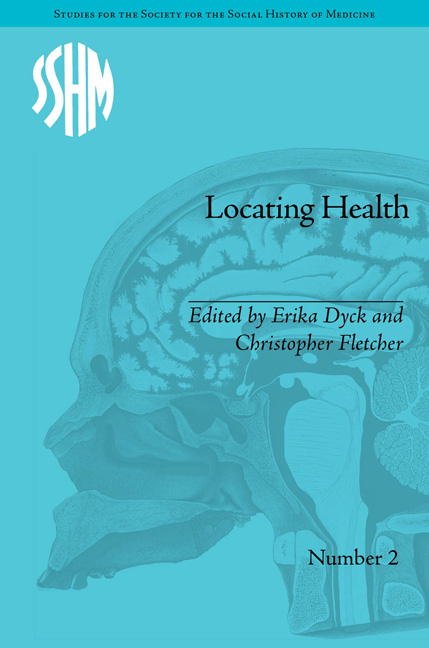Book contents
- Frontmatter
- CONTENTS
- List of Tables
- List of Contributors
- Acknowledgements and Preface
- Introduction: Healthscapes: Health and Place among and between Disciplines
- 1 Placing Maternal Health in India
- 2 Putting Medicine in its Place: The Importance of Historical Geography to the History of Health Care
- 3 Finding Place in The Big-Little World of Doc Pritham: Telling Medical Tales about Northwoods Maine, 1920s–70s
- 4 Putting Hyperactivity in its Place: Cold War Politics, the Brain Race and the Origins of Hyperactivity in the United States, 1957–68
- 5 Why Canada Has a Universal Medical Insurance Programme and the United States Does Not: Accounting for Historical Differences in American and Canadian Social Policies
- 6 Alberta Advantage: A Canadian Proving Ground for American Medical Research on Mustard Gas and Polio in the 1940s and 50s
- 7 Placing Illness in its Cultural Territory in Veracruz, Nicaragua
- 8 Chronic Disease in the Yukon River Basin, 1890–1960
- 9 An Ideal Home for the Consumptive: Place, Race and Tuberculosis in the Canadian West
- 10 Serbian Landscapes of Dreamtime and Healing: Clear Streams, Stones of Prophesy, St Sava's Ribs, and the Wooden City of Oz
- Notes
- Index
2 - Putting Medicine in its Place: The Importance of Historical Geography to the History of Health Care
- Frontmatter
- CONTENTS
- List of Tables
- List of Contributors
- Acknowledgements and Preface
- Introduction: Healthscapes: Health and Place among and between Disciplines
- 1 Placing Maternal Health in India
- 2 Putting Medicine in its Place: The Importance of Historical Geography to the History of Health Care
- 3 Finding Place in The Big-Little World of Doc Pritham: Telling Medical Tales about Northwoods Maine, 1920s–70s
- 4 Putting Hyperactivity in its Place: Cold War Politics, the Brain Race and the Origins of Hyperactivity in the United States, 1957–68
- 5 Why Canada Has a Universal Medical Insurance Programme and the United States Does Not: Accounting for Historical Differences in American and Canadian Social Policies
- 6 Alberta Advantage: A Canadian Proving Ground for American Medical Research on Mustard Gas and Polio in the 1940s and 50s
- 7 Placing Illness in its Cultural Territory in Veracruz, Nicaragua
- 8 Chronic Disease in the Yukon River Basin, 1890–1960
- 9 An Ideal Home for the Consumptive: Place, Race and Tuberculosis in the Canadian West
- 10 Serbian Landscapes of Dreamtime and Healing: Clear Streams, Stones of Prophesy, St Sava's Ribs, and the Wooden City of Oz
- Notes
- Index
Summary
Introduction
Reports on the economy, environment and identity often initiate debates concerning globalization, migration, devolution and displacement and usually the erosion of place in the modern world. In academia, with the decline of grand narratives, many scholars unanimously accept theoretical approaches that preach ‘multiple sites of belonging’. Identities are no longer rooted in single, stable locales and individuals once regarded as out of place are now more easily situated in a world of process and elasticity. In historical studies, a preoccupation with place is associated with the rise of cultural history and a proliferation of micro-studies, most scholars engaging with their own unique places. Though always overtly and appropriately contextualized, these studies do not always speak to each other, even when situated within the same region. As a result, historians have been overwhelmed by detail and greater efforts are required by scholars to identify commonalities in studies of different places.
There is no better time for historians to engage with the work of geographers. Almost all historians study particular places, and place is the geographer's principle object of study. The subject, however, is unfamiliar territory to many scholars, and remains a slippery subject, even to the specialist. Most academics, for example, use the terms place and space interchangeably. Often, place is simply regarded as a set of coordinates, or a point on a map.
- Type
- Chapter
- Information
- Locating HealthHistorical and Anthropological Investigations of Place and Health, pp. 29 - 42Publisher: Pickering & ChattoFirst published in: 2014



